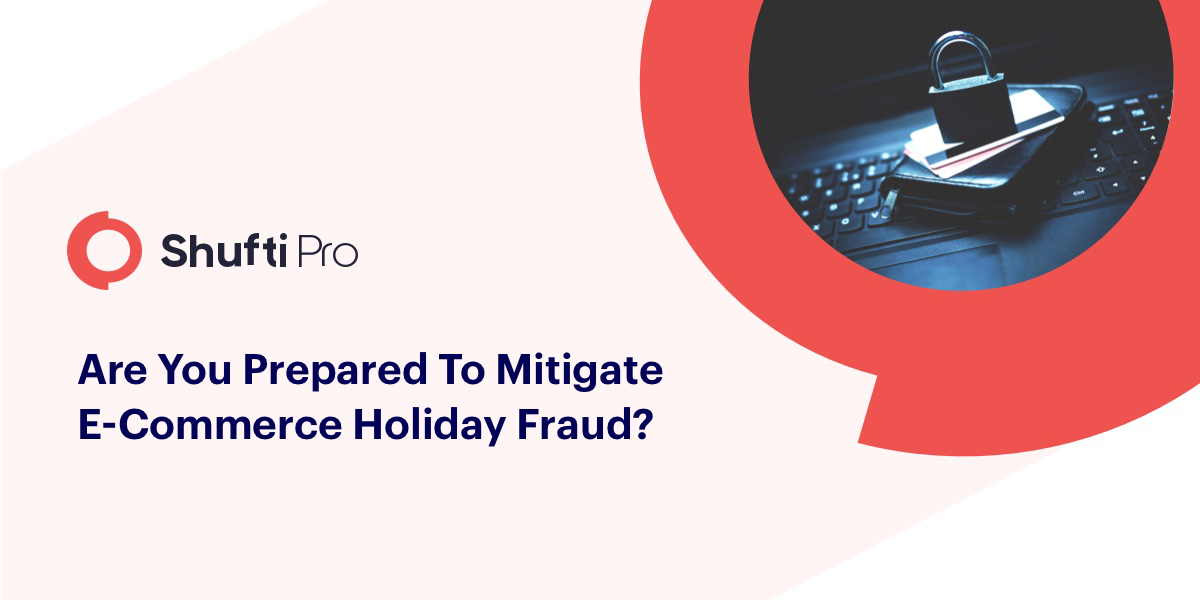4 Fraud Prevention Tips For Your E-commerce Business this Holiday Season

With the holiday shopping season in full swing, e-commerce fraud risk is a glaring reality that needs to be accounted for before it translates into large business losses. By 2019, there will be an estimated 1.92 billion global digital buyers that need to be served, as well as authenticated. While this opens up countless business opportunities for vendors, it also indicates the need to single out bad actors that commit high-value identity fraud every year.
Cybercriminals and scammers are catching up growing digital buying trends and breaking their way into legitimate online transactions. The holiday season is the ideal time for hackers and identity thieves to commit identity fraud due to the large volume of sales that are processed in a small amount of time.
According to data from ACI Worldwide, fraud attempts spiked by 30% over the previous holiday season, in millions of online transactions especially on Christmas Eve. Fraudsters are trying to get past busy sales representatives and burdened software that miss the smallest details required to a naughty holiday buyer.
Here are 4 tips for your business to defend itself from E-commerce Fraud this holiday season:
1- Understand holiday e-commerce fraud types
With every passing day, we’re looking at innovative forms of online buying options, such as P2P payment gateways and social media buying solutions. While it’s not fair to say that the digital buying economy is a new concept, it is also true that firms are still struggling to understand the types of risk they are faced with.
Digital ID theft and fraud is the most common and well known type of online scam that has affected millions of people across the world, and caused consumers to lose up to $1.48 billion in 2018, according to the Insurance Information Institute. During the holiday season, the percentage of fraudulent transaction is expected to increase manifold, especially card-not-present fraud.
Other types of fraud include:
- Account Takeover Fraud – Legitimate accounts are hacked by imposters to make purchases
- Phishing Scams – Fraudulent attempts to gain personal user information
- Credit Card Fraud – Fraud committed using a credit card as illegal source of funds in a transaction
- Card-not-present Fraud – Absence of actual card when carrying out a transaction
- Friendly Fraud – Actual transactions made by cardholders, later disputed by themselves to claim chargebacks
2- Upgrade fraud prevention tools and identity verification services
To find out if your holiday season customers are actually who they claim to be use authentic and reliable verification services. Security barriers in online environments are becoming easy to intercept, as technology lands in the hands of both good and bad actors.
With the types of frauds listed above, hackers are learning to commit financial crimes without leaving a trace. This is where automated identity verification services with AI based features need to be utilised for strong risk prevention shield. Identifying users at source entails thorough KYC, AML and KYB checks with the following services:
Automated Fraud Prevention Solutions
Specialised features such as liveness detection and consent verification provide users and businesses with a level of trust that is otherwise impossible to achieve with manual verifications for large sales volumes. In this respect, biometric verification is also gaining popularity due it its convenience, especially for mobile users, and can be employed to verify users in a matter of seconds.
At the same time, it is important to note that automated fraud prevention and identity verification processes need to be used with caution due to the inevitable risk of accepting fraudulent orders, resulting in high chargebacks. Human intelligence is therefore an integral part of the verification process for complete accuracy.
3- Monitor key e-commerce sales metrics
With fraud prevention software and human review of transactions, it is possible to identify red flags during peak season. Narrowing down geographical location through IP and browser information also helps preventing fraud well in time. Suspicious orders can be identified by looking at buying patterns and understanding how a sudden change in purchase activity can really be from a fraudulent source.
Marketing and sales metrics such as click-through rates, conversion rates and chargebacks must be reported on an ongoing basis by business executives to stay on top of any irregular patterns in e-commerce sales. Sometimes, indicators as simple as unusual delivery addresses or inaccurate customer credentials can impact sales trends for a busy quarter. However, additional authentication methods must be placed to review such anomalies before taking stern action and blacklisting authentic customers erroneously.
Read more about how you can prevent frauds by following AML and KYC regulations
4- Customise a fraud mitigation plan for the holidays
In 2018, holiday season retail e-commerce spending totalled almost $120 billion, and Cyber Monday in 2019 alone racked up close to $9.4 billion in online spending, the biggest ever recorded. This means greater handling of customers, sales and transactions by regular as well as temporary staff. A fool-proof plan to handle these both manually and digitally must be developed well in advance to ensure the security of successful deliveries.
To process more orders than usual, sales reps will have to think about the numerous queries that new and returning customers will have. Moreover, process to approve and decline orders also need to be streamlined in order to check for inconsistent personal details such as delivery address and credit card details.
Well coordinated marketing and sales team are always able to maximise returns from promotions, deals, coupons and website traffic. Any miscommunication at this stage can lead to large financial losses as well as tangible damage to brand reputation. Examining historical patterns in consumer history are also helpful indicators for discerning fraudulent transactions and saving both time and money.
All in all, e-commerce vendors must steer clear of impending online fraud schemes by employing strict safeguards, as well as becoming aware of newer types of threats that may hurt them, especially in busy holiday season.










